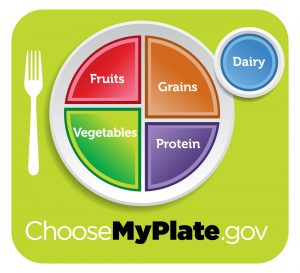Bulletin #4393, Eating for Health with MyPlate: Oils
Prepared by Extension Educator Kate Yerxa and Extension Specialist Leslie Forstadt, University of Maine Cooperative Extension. Reviewed by Extension Educator Alan Majka, University of Maine Cooperative Extension.
For information about UMaine Extension programs and resources, visit extension.umaine.edu.
Find more of our publications and books at extension.umaine.edu/publications/.
Like most Americans, Mainers eat too much fat, sugar, sodium, and refined grains. These Eating for Health with MyPlate fact sheets can start you down the path to good health. Each one is about a different part of the 2020-2025 Dietary Guidelines for Americans and MyPlate healthy eating guidelines. You can learn what each part is, why it’s important, and how it matters to you and to your family. The MyPlate food groups are Grains, Vegetables, Fruits, Dairy, and Protein. This fact sheet explains the Dairy Group.
Oils are not considered a food group, but they supply healthy fats in your diet.
Oils are fats that are liquid at room temperature. Oils come from different plants and types of fish. Some common types of oils include olive oil, sunflower oil, soybean oil, safflower oil, corn oil, and canola oil. Some foods are naturally high in oils. These foods include nuts, olives, avocados, and some kinds of fish.
How much oil should adults eat?
The amount of oil you need each day is different for everyone. The average adult needs about 2,000 calories per day. In a 2,000 calorie diet, women can have 5 to 6 teaspoons of oil a day. Men can have 6 to 7 teaspoons. Measuring teaspoons of oil can help you know how much oil you get from foods. The chart below provides a guide to the amount of oil in foods.
| Amount of Food | Amount of Oil in Food | |
|---|---|---|
| Oils | ||
| Vegetable oils (such as canola, corn, cottonseed, olive, peanut, safflower, soybean, and sunflower) | 1 Tablespoon | 3 teaspoons |
| Foods rich in oils | ||
| Margarine, soft (trans fat-free) | 1 Tablespoon | 2 1/2 teaspoons |
| Mayonnaise | 1 Tablespoon | 2 1/2 teaspoons |
| Italian dressing | 2 Tablespoons | 2 teaspoons |
| Olives, ripe, canned | 4 large | 1/2 teaspoon |
| Avocado | 1/2 medium | 3 teaspoons |
| Peanut butter | 2 Tablespoons | 4 teaspoons |
| Mixed nuts | 1 ounce | 3 teaspoons |
| Sunflower seeds | 1 ounce | 3 teaspoons |
Why oils?
Most oils are high in monounsaturated fats or polyunsaturated fats, and low in saturated fats. Monounsaturated and polyunsaturated fats are healthier fats. They are found in fish, nuts, and vegetable oils. They do not raise “bad” cholesterol levels in the blood. These types of fats contain essential fatty acids that your body needs. They also have vitamin E.
Limit solid and dairy fats
Fats that are solid contain more saturated fats and/or trans fats. They tend to raise “bad” blood cholesterol, which can increase the risk of heart disease.
- Saturated fats are fats that are found in foods that come from animals. These foods include meat, full-fat dairy products, poultry skin, butter, and lard.
- Trans fats are fats that are made from liquid oils, and made solid through a chemical process. These fats are found in solid shortening, many snack foods, and pre-packaged baked goods.
Try limiting the amount of butter and stick margarine you eat. Instead, use oils such as olive, safflower, or canola oil. This will reduce the amount of saturated and trans fats in your diet. Also, use low-fat (1%) or non-fat dairy products instead of whole milk or full-fat cheeses. This will reduce the amount of saturated fat you eat.
How do I put healthy oils into my diet?
Oils are necessary for health. But too much food with oils can add too many calories to your diet. This can make you gain weight. Oils and solid fats are both high in calories: about 120 calories per tablespoon. With this in mind, it is important to balance total calorie intake by eating no more that the recommended amount of oil. Remember that this amount depends on your personal needs. In any case it is no more than 5 to 7 teaspoons a day.
References
U.S. Department of Agriculture and U.S. Department of Health and Human Services. Dietary Guidelines for Americans, 2020-2025. 9th Edition. December 2020. Available at DietaryGuidelines.gov.
U.S. Department of Agriculture. MyPlate website. 2021. https://www.myplate.gov

Information in this publication is provided purely for educational purposes. No responsibility is assumed for any problems associated with the use of products or services mentioned. No endorsement of products or companies is intended, nor is criticism of unnamed products or companies implied.
© 2011, 2017, 2021
Call 800.287.0274 (in Maine), or 207.581.3188, for information on publications and program offerings from University of Maine Cooperative Extension, or visit extension.umaine.edu.
In complying with the letter and spirit of applicable laws and pursuing its own goals of diversity, the University of Maine System does not discriminate on the grounds of race, color, religion, sex, sexual orientation, transgender status, gender, gender identity or expression, ethnicity, national origin, citizenship status, familial status, ancestry, age, disability physical or mental, genetic information, or veterans or military status in employment, education, and all other programs and activities. The University provides reasonable accommodations to qualified individuals with disabilities upon request. The following person has been designated to handle inquiries regarding non-discrimination policies: Director of Equal Opportunity and Title IX Services, 5713 Chadbourne Hall, Room 412, University of Maine, Orono, ME 04469-5713, 207.581.1226, TTY 711 (Maine Relay System).


